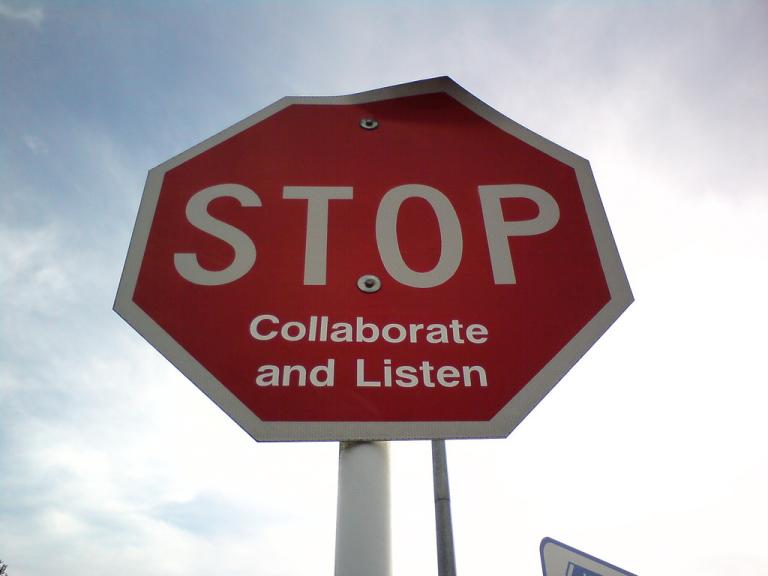There’s a lot of buzz about collaboration these days. Whether in industry or the social sector, it seems that “working together” is in vogue. Why collaborate? What counts as collaboration? How do we know when collaboration is the right play? I’ll answer those questions in this post. For an extended conversation on the subject which was recorded right on the heals of the Super Bowl with my friends Ken Kinard of Accent Interactive and Mike Boyes of Credo Consulting, listen to the podcast WorkWise, Episode #5.
The Increasing Need For Collaboration
The increasing complexity of social and marketplace challenges, and the constant drive for greater efficiency mean that organizations tend to staff lean and therefore frequently face obstacles that are beyond their capacity. Social problems are increasingly complex so that the head winds that come against non-profits and churches can seem insurmountable. This challenge-dynamic drives leaders to import expertise through various forms of collaborative partnerships.
Steps Toward Collaboration
- Awareness: Becoming aware of the key players in a given space or organizational domain is the foundation for future relationships and collaboration. Many leaders live and work in silos. Building bridges of connection is where collaboration begins. Networking events, introductory dinners, and conferences can foster the awareness that leads to collaborative partnerships.
- Communities of Practice: A Community of Practice is a research-based model for leaders in a similar domain to craft and pursue a prioritized agenda together. They often collaborate on learning, such as when a group of program directors in the Faith and Work space gather to share challenges and best practices.
- Cooperative Projects: Cooperative projects are pre-collaborative experiments, where organizations or leaders engage in a short-term, joint initiative. For example, a production company and a web design company may join a conference creator in the early stages of event planning to insure alignment and enhance creativity.
- Ongoing Collaborative Relationships: A true collaboration is an ongoing relationship where various players all work together to solve the same problem by bringing their unique abilities and capacities to the table.
The best model for collaboration is found in this piece by the Stanford Social Review. Read their peace on collective impact.
The best example of social-sector collaboration here in New York is found amoung the Rescue Missions. At least three of them are working together on a regular basis to attack the overwhelming problem of homelessness among 100,000 city residents.
Requirements for Success Collaboration: At least three factors are prerequisites for successful collaboration.
- Shared pain: when players in a given market or service area are overwhelmed and stretched beyond capacity by the enormity of their challenges, they are incentivized to talk! The out-of-control New York of the late 80’s drove faith leaders here together.
- Humility: when players recognize they cannot cover all the bases, they are open to exploring and drawing on the competencies of others.
- Win-win creativity: collaboration is only sustainable when each collaborator can draw upon core competencies and build their brand. Competitors are not collaborators.
The Scripture Connection: There is a powerful picture of collaboration crafted by the Apostle Paul in his first letter to the Corinthians, chapter 12. Here he likens the community of faith to a body, a unit where each one has a distinct and vital role to play in their contribution to the whole. Whether it’s pastors working together to address a challenge in their neighborhood, people of faith working together to address a challenge like the Syrian refugee crisis, or a group of entrepreneurs attempting to disrupt something destructive like payday lending, body-thinking may be the best path forward for tackling complex challenges. A healthy body = collaboration in action.
To Collaborate or not Collaborate?
When you face your next insurmountable challenge, perhaps collaboration is the right play. It should at least be on the table because sometimes the rock is to heavy to move by yourself.
About the Author: Dr. Chip Roper writes Marketplace Faith from New York City, where he is the director of Marketplace Engagement at the New York City Leadership Center. Chip is convinced that a central piece of God’s plan for any city or community is the work that people do each day. He has also found that the challenge of getting this message out and into people’s lives is too big for any one organization, so he’s an advocate of intelligent collaboration. You can learn more about him here. Chip is available for speaking, consulting, and coaching engagements. Inquire via email: [email protected].
______
Pic: https://c2.staticflickr.com/4/3126/2900631165_dcb8fe8c1f_b.jpg













